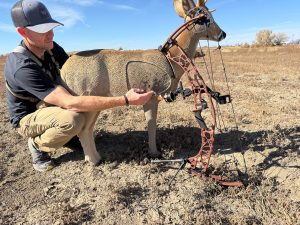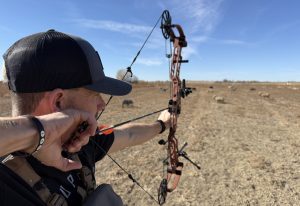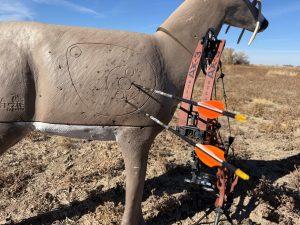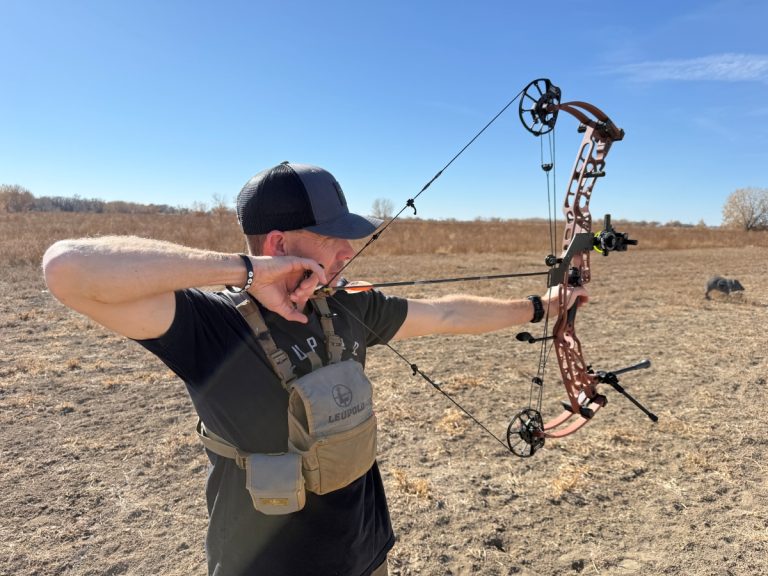I’ve been shooting Hoyt bows since 2007, when a small archery shop in Pueblo, Colorado, handed me a Hoyt Kumara and asked if I’d be their shop shooter. That bow carried me to podiums in the summer and through blood-red prairies and cedar-choked canyons in the fall—and it kicked off a long obsession with Hoyt Alpha X flagship compound bows. Since then, I’ve hunted with and tested more than 20 Hoyt models, from legendary rigs like the Alpha Max to modern carbon killers like the RX-8 and RX-9. Some bows have stuck with me, others not so much. The 2025 RX-9, for instance, delivered speed but sacrificed a bit of shootability, while the aluminum AX-2 felt smoother and more forgiving. Enter Hoyt’s 2026 aluminum flagship: the Hoyt Alpha AX-3 33. After two weeks living with this bow—from setup in my garage shop, to tuning with the new XTS Tuning System, to long-range shooting on the outdoor range—I can say this 33-inch axle-to-axle rig is not just an incremental update. The Hoyt AX-3 33 is the quietest, fastest, and most shooter-friendly Hoyt I’ve ever put on target.
The RX-8 is my favorite carbon bow to date, and though I had an excellent year in 2025 with the 33-1/2-inch axle-to-axle (ATA) RX-9, I felt Hoyt compromised shootability for increased speed. The manufacturer’s 2025 aluminum flagship, the AX-2, was smoother and more forgiving than the RX-9. The question I was asking myself concerning Hoyt’s new 2026 bow launch was the same question every archer starts kicking around this time of year: What will Hoyt do to make its 2026 flagship bow line better than its 2025 flagship line?
Although I have yet to receive Hoyt’s all-new Carbon RX-10, I’ve spent the past two weeks testing the new for 2026 Hoyt Alpha AX-3 33 aluminum riser model. In true Hoyt fashion, the bow maker once again launched a litany of carbon and aluminum-riser bows. The RX-10 family is available in axle-to-axle lengths of 30-1/2 inches and 33-1/2 inches, as well as a 30-5/16-inch short draw model and a 33-1/4-inch long draw model. The AX-3 includes four axle-to-axle models that include 29-1/2, 33-5/16, 29-1/2, and 33-1/4. Hoyt went the extra mile to ensure there is a flagship bow for every archer. The manufacturer also launched the budget-friendly 328 fps, 7-inch brace height Enduro. The Enduro features Hoyt’s proven HBX cam and offers In-Line accessories, including the Sight Pic-Rail, Integrated rest, SuperLite quivers, and Go Stix.
First Impressions: Hoyt Alpha AX-3 33
I’m not a color geek. I don’t care about flashy strings that match my arrow vanes or a multi-color riser with black limbs. All I want is a compound bow that is easy to tune, draws like butter, holds on target like a rock, and is a joy to shoot. Even though color and style matter very little to me, I didn’t love the head-to-toe look of Hoyt’s Georgia Clay. To me, my new-for-2026 compound looked like a rose. It would have looked sick with black limbs, but the pure Georgia Clay was a little too much burgundy for me. Hoyt’s other new color, Sandstorm, looks excellent.

The third generation of the Alpha X didn’t reveal much that stood out to me upon first inspection. Mirroring the AX-2, a bow I loved, the AX-3 sports the uber-adjustable HBX Gen 4 Cam System. One of the most adjustable and user-friendly cam systems ever developed, the HBX Gen 4 Cam allows for draw length adjustment in 1/4-inch increments, ensuring precise draw length settings. Shooters also have the choice of let-off settings of 75, 80, and 85 percent via easy-to-adjust cable-stop arms. The arms also allow backwall settings of Hard and Xtra Hard.
The In-Line Accessory Mounting System is back. Hoyt goers can easily mount their sight to the front of the riser and their rest to the back of the riser. This In-Line System reduces accessory weight by eliminating the need for accessory mounting blocks, bars, and screws. Plus, with the sight, rest, etc. in line with the bow and not off to one side, balance is improved.
The Biggest Improvement is the XTS Tuning System
Don’t get me wrong, I was happy with what I was seeing, but I wasn’t seeing any new features for the year. Then I looked at the limb pockets. Boom! Hoyt did it! An area where I felt Hoyt missed the boat in 2025 is now fully improved. In past years, if shooters couldn’t achieve a perfect paper tear by altering the rest or position of the D-loop, the bow needed to be shimmed. Shimming requires the removal of the axle pins and swapping or changing the spacers that sit between the limbs and the cam. Although the process isn’t overly complicated, it did require a bow press, shims, and general bow technician knowledge.

For 2026, Hoyt adds the XTS Tuning System. This patent-pending tuning system ensures quick, simple, and precise tuning with no bow press required. With the XTS Tuning System, Hoyt owners can tune out right, left, up, and down tears, and if they so choose, shim tuning is still available. Ideal for bare shaft and broadhead tuning, Hoyt includes a downloadable, in-depth white paper chart that guides you through the XTS Tuning System.
Setting Up the AX-3 33 Build in My Garage Shop
Years ago, I built a bow shop in my garage. That shop gets a lot of use. One of my favorite things to do is set up a new bow, shoot it, and then tune it. As expected, the In-Line System made mounting Spot-Hogg’s Boonie PM 5-Pin a breeze. Loosen a set screw in the PM mounting bar and choose from one of three pre-cut grooves in the front of the AX-3’s riser. Rest mounting is equally straightforward. Concerning arrow rests, there is only one rest that I trust—only one that has never let me down when it comes to the moment of truth—QAD. Quality Archery Designs forever changed rest mounting when the manufacturer developed the IMS System. The IMS System allows the rest, in this case, the QAD Integrate MX2, to clamp to the back frame of the riser via a dual-clamping system. The system is absolute and streamlined.

The Hoyt Alpha AX-3 33 pressed easily in my Last Chance Archery press. Insertion of the peep and the rest of the down-cable cord was easy. The limb bolts to pop or chatter, which equates to an excellent riser-to-pocket build.
Set at a draw length of 29 inches, a let-off of 80 pounds, and a Hard backwall, I loaded a 286.4-grain Easton 5.0 340 spine arrow and pulled the bow back. My digital Last Chance bow scale showed a peak draw weight of 73.1 pounds, but the bow came back like butter.
Standing in front of a large BLOCK Range Target, I drew the bow back, this time with my TRU Ball HBC hinge, settled in, and sent an arrow. Not only does the AX-3 33 draw like butter, but it holds like a rock, and is dead quiet at the shot. One of my biggest complaints concerning my Carbon RX-9 was that the cam system wanted to pull me into the shot. I hate sacrificing shootability for speed. With the AX-3 33, I can draw, crawl into my anchor, trust my pin float, and push and pull until the release fires the bow.
How to Tune the Hoyt Alpha AX-3 33 Without a Bow Press
Some people think I’m crazy, but what I do works for me. I never paper tune, bareshaft tune, or broadhead tune until I’ve shot no less than 100 arrows through a new bow. Why?
I want to get used to the bow’s grip, how it shoots, and get any string/cable stretch out. As long as my arrow isn’t producing crazy vertical or horizontal nock travel, I keep shooting. Though I did detect a slight right arrow kick, it was extremely minor. My three-shot group arrow speed average was 316 fps, which is significantly faster than my AX-2. Plus, the AX-3 is even smoother and quieter than the AX-2. Using a Reed R8050 Sound Meter, the AX-3 33 produced a three-shot dB reading of 62.2, which is quieter than last year’s RX-9 (the quietest compound bow I tested in 2025).

After 104 arrows shot between 10 and 100 yards, I shot the Alpha AX-3 33 through paper. The tear was perfect up and down, but a slight right tear was present. Using Hoyt’s downloadable XTS tuning chart, I positioned the bow in a bow vise so I was looking at the front of the bow. This means the limb pockets were facing toward me. Next, I used a 3/32 Allen wrench to loosen the shuttle block locking screws on the top and bottom limb pockets. The shuttle block locking screws are visible when you look at the limb pockets. You will see five laser-engraved marks and the shuttle block screws. Next, I inserted the 3/32 Allen wrench into the top right hole on the front pocket and made a slight clockwise turn. Next, I inserted the wrench into the top left hole and made the same clockwise adjustment. After making adjustments to the top pocket, I did the same to the bottom pocket. After locking the shuttle block screws down, I took another shot through paper. The tear was perfect.
The XTS Tuning System allows for 1 inch of paper-tear clean-up. If you have a tear greater than 1 inch, you need to alter your rest or swap spacers.
The Hoyt Alpha AX-3 33 was one of the easiest bows I have ever tuned. If you can turn an Allen wrench and read simple instructions, you can tune this bow without a bow press. The XTS Tuning System is fast, easy, and ultra-efficient. And, best of all, when you tune your bow, the XTS System doesn’t affect your point of impact. This means you don’t have to change your sight every time you make a tuning change. The XTS Tuning System is a significant win for Hoyt!
The Hoyt Alpha AX-3 33 On The Range
Though I haven’t spilt blood with the Hoyt Alpha AX-3 33 yet, I can pen that it is the quietest, fastest, and most pleasant-shooting Hoyt I’ve ever fired. As I write this, I find myself typing faster and faster so I can get back out on the range and spend more time behind the bow. There is no portion, from setup to tuning, to the range, where the AX-3 disappoints. It is compound bow engineering perfection!

Over the course of three weeks, I’ve shot field points, fixed, and mechanical broadheads at block-style and 3D targets from 10 to 120 yards. This bow is a tack driver. The draw cycle is butter; it sits like a well-trained Labrador retriever at full-draw, resisting torque and improving the shooter’s natural point of aim, and if you do your job and execute a good shot by allowing the release to fire the bow, your arrow will replace your sight pin.
Final Thoughts on The Hoyt Alpha AX-3 33
I’ve always thought it strange that bow makers launch new compound models every year and kill the previous year’s models. I don’t think bowhunters need or should buy a new compound bow every single year. This year, though, if you’re in the market for a new compound bow that will serve you well from the Rockies to the Midwest whitetail woods, check out Hoyt’s AX-3 33. It’s money well spent.
Per our affiliate disclosure, we may earn revenue from the products available on this page. To learn more about how we test gear, click here.







